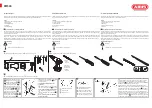
Work Environment Safety
CAUTION
Used with the safety alert symbol, indicates a hazardous
situation which, if not avoided, could result in minor or
moderate injury.
1. When possible, move the work to a location well away from
combustible materials. If relocation is not possible, protect the
combustibles with a cover made of fire resistant material.
2. Remove or make safe all combustible materials for a radius of
10 metres around the work area. Use a fire resistant material
to cover or block all doorways, windows, cracks, and other
openings.
3. Enclose the work area with portable fire resistant screens.
Protect combustible walls, ceilings, floors, etc., from sparks
and heat with fire resistant covers.
4. If working on a metal wall, ceiling, etc., prevent ignition of
combustibles on the other side by moving the combustibles
to a safe location. If relocation of combustibles is not possible,
designate someone to serve as a fire watch, equipped with a
fire extinguisher, during the welding process and well after the
welding is completed.
5. Do not weld or cut on materials having a combustible coating
or combustible internal structure, as in walls or ceilings,
without an approved method for eliminating the hazard.
6. After welding, make a thorough examination for evidence of
fire. Be aware that visible smoke or flame may not be present
for some time after the fire has started. Do not weld or cut in
atmospheres containing dangerously reactive or flammable
gases, vapours, liquids, and dust. Provide adequate ventilation
in work areas to prevent accumulation of flammable gases,
vapours, and dust.
7. Do not apply heat to a container that has held an unknown
substance or a combustible material whose contents, when
heated, can produce flammable or explosive vapours. Clean
and purge containers before applying heat. Vent closed
containers, including castings, before preheating, welding, or
cutting.
www.duralloy.net.au
|
1300 369 456
Electricity Can Kill
DANGER!
Touching live electrical parts can cause fatal shocks or
severe burns. The electrode and work circuit is electrically
live whenever the output is on.
The input power circuit and machine internal circuits are also live
when power is on. In semi-automatic or automatic wire welding,
the wire, wire reel, drive roll housing, and all metal parts touching
the welding wire are electrically live. Incorrectly installed or
improperly grounded equipment is a hazard.
1. Do not touch live electrical parts.
2. Wear dry, hole-free insulating gloves and body protection.
3. Insulate yourself from the work and the ground using dry
insulating mats or covers.
4. Disconnect input power before installing or servicing this
equipment. Lock input power, disconnect switch open, or
remove line fuses so power cannot be turned on accidentally.
5. Properly install and ground this equipment according to
national, state, and local codes.
6. Turn off all equipment when not in use. Disconnect power to
equipment if it will be left unattended or out of service.
7. Use fully insulated electrode holders. Never dip the holder
in water to cool it or lay it down on the ground or the work
surface. Do not touch holders connected to two welding
machines at the same time or touch other people with the
holder or electrode.
8. Do not use worn, damaged, undersized, or poorly spliced
cables.
9. Do not wrap cables around your body.
10. Connect work piece to a good electrical ground.
11. Do not touch the electrode while in contact with the work
(ground) circuit.
12. Use only well-maintained equipment. Repair or replace
damaged parts as soon as practical.
13. In confined spaces or damp locations, do not use a welder
with AC output unless equipped with a voltage reducer.
Arc rays from the welding process produce intense heat and
strong ultraviolet rays that can burn eyes and skin. Use the
following table to select the appropriate shade number for a
Welding Helmet or Welding Face Shield.
12
ARC 161/201 PFC
OWNER’S MANUAL


































